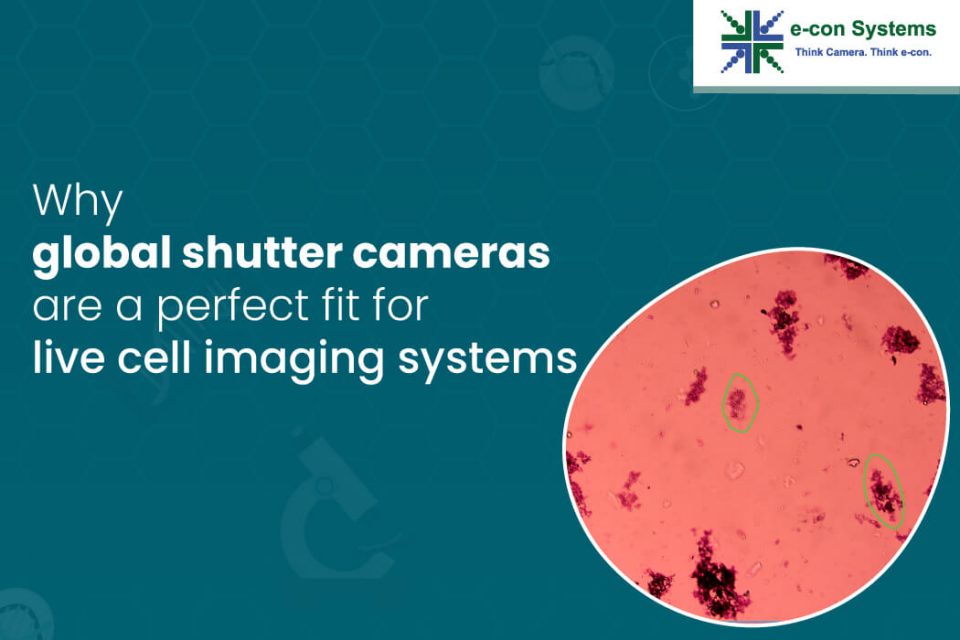Global shutter cameras are a valuable tool for live cell imaging because they offer superior image quality, faster frame rates, and better synchronization with other imaging equipment. This makes it easier to capture and analyze accurate, high-quality images of live cells in real time.
In this article, you’ll learn more about live cell imaging and global shutter cameras, as well as the camera features that are necessary for your life science application. You’ll also get a close look at e-con Systems’ See3CAM_50CUGM (based on the Sony Pregius IMX264 CMOS sensor) and find out why it’s a perfect fit for live cell imaging systems.
Why global shutter cameras are generally preferred
First, let’s start with a better understanding of global shutter cameras. An image sensor’s global shutter mode allows all the sensor’s pixels to start and stop exposing simultaneously for a programmed exposure period. Ultimately, it initiates the pixel data readout before proceeding row by row to read all the pixel data. This ensures distortion-free images, which means they are a great fit for capturing high-speed moving objects.
Hence, these cameras offer superior image quality compared to rolling shutter cameras. They produce sharper, clearer, and more accurate images, especially for fast-moving subjects or when capturing images under fast-changing illumination conditions.
Read: Global Shutter Cameras vs. Rolling Shutter Cameras
What is live cell imaging?
Live cell imaging refers to the process of capturing images of living cells in real time using microscopy or other imaging techniques. This technique enables scientists and other researchers to observe the behavior of cells, such as their movement, interactions with other cells, and changes in shape or structure, as they occur in real time.
There are several different imaging techniques that can be used for live cell imaging, such as:
- Bright field microscopy
- Fluorescence microscopy
- Confocal microscopy
- Super-resolution microscopy
It is important to note that each technique has its own strengths and limitations, and the choice of technique will depend on the specific research question being addressed.
What features make global shutter cameras ideal for live cell imaging?
The entire sensor in a global shutter camera is exposed to light at once, so there is no time delay between the exposure of one pixel and the next. This allows for more precise timing of events and avoids the rolling shutter effect. In live cell imaging, it is important to capture images quickly and accurately, and a global shutter camera can help achieve this goal.
Now, let’s look at some of the features that make global shutter cameras ideal for live cell imaging.
Improved image quality
As mentioned earlier, global shutter cameras produce sharper and clearer images. This results in better visualization and analysis of live cells.
Distortion-free images (reduced motion blur)
Global shutter cameras capture images of the entire frame without any distortion. It means that all parts of the image are captured at the same moment. This is essential for capturing accurate, high-resolution images of live cells that may be moving or changing rapidly – resulting in reduced motion blur. In comparison, rolling shutter cameras capture images line by line – causing distortion and motion blur.
Improved synchronization
Global shutter cameras can be synchronized more precisely with other imaging equipment, such as microscopes or illumination systems. So, you can achieve better image quality and more accurate analysis.
Consistent illumination
Rolling shutter cameras can cause inconsistent illumination across the image due to the scanning process, resulting in uneven exposure of the cells. Global shutter cameras capture the entire image at once, resulting in consistent illumination.
See3CAM_50CUGM – the new all-in-one life science camera solution by e-con Systems
e-con Systems has nearly two decades of experience in designing and manufacturing embedded camera modules and solutions for various industries. We have also helped our customers transform the medical and life science industry with our state-of-the-art off-the-shelf and customizable camera solutions.
One of our latest releases is the See3CAM_50CUGM – a 5MP high-sensitivity fixed focus camera based on the Sony Pregius IMX264 CMOS sensor. The See3CAM_50CUGM is suitable for life science applications, such as live imaging devices, since it is equipped with back-illuminated pixel technology and a large pixel size of 3.45µm. Furthermore, this global shutter camera feature also captures distortion-free images of fast-moving targets.
Interested in evaluating our camera solutions for your life science applications? Please write to us at camerasolutions@e-consystems.com.

Balaji is a camera expert with 18+ years of experience in embedded product design, camera solutions, and product development. In e-con Systems, he has built numerous camera solutions in the field of ophthalmology, laboratory equipment, dentistry, assistive technology, dermatology, and more. He has played an integral part in helping many customers build their products by integrating the right vision technology into them.




